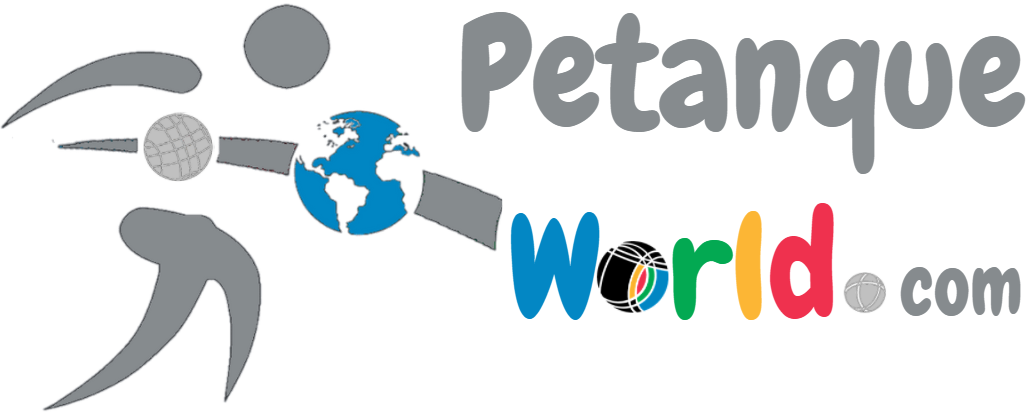How to point in petanque ?
- Home
- /
- How to point ?
Become a good pointer
Introduction
To point is the action to throw a boule, in order to stop its movement near to the jack. Mastering the point is the basis of any good petanque player. The best shooters in the world are above all very good pointers. Do not hope to win a competition if you do not know how to point, because it is impossible ! Before starting to point, it is essential to understand the basics of petanque, do not hesitate to consult this tutorial by clicking here : The basics of petanque
The pitch / The court
Types of pitch/court
Petanque is an all-terrain sport, you can play anywhere ! Here is an exhaustive list of the types of terrain you may encounter :
- "Lissette" : This is certainly the most frequent court. You might hear it said : these are "roulette" pitch. These kinds of terrain are rather simple to play and you can easily be surprised by beginners ...
- "Sablette" : That is the equivalent of the "lissette" court with more sand. It can be red sand or grey sand most of the time. Compared to "lissette" terrain, it will be necessary to launch your ball stronger to point, and for the shooters it will be necessary to privilege the force more than the flexibility.
- Gravels : Good players generally prefer this type of ground, as they are more selective.
- Pebbles : One of the most difficult terrain. It may be wise to lob your ball if you want to achieve your goal !
- Asphalt : Very complex, it is still quite rare to play on these types of court, but some players like to try it out !
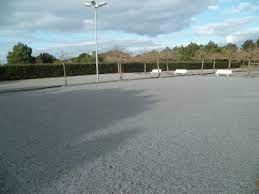 petanque court with grey sand ground
petanque court with grey sand ground
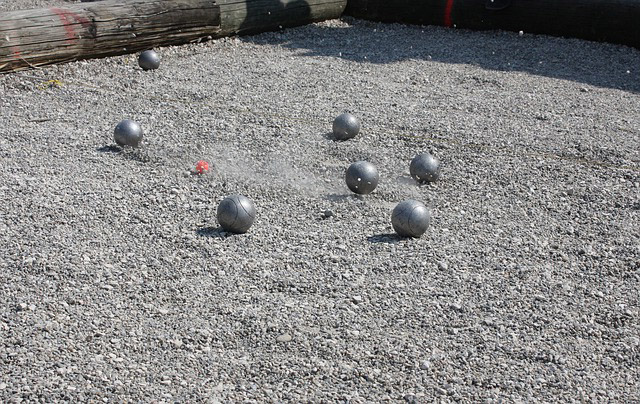 petanque court with gravel ground
petanque court with gravel ground
 analyze the petanque ground before pointing
analyze the petanque ground before pointing
How to analyze the court ?
Before throwing your ball, you should observe the ground. Please take the time to identify holes, bumps, slopes, stuck areas, large stones, obstacles and others ...
The slopes represent the inclination of the terrain, sometimes leans to the left or to the right, or it goes up or down. Identifying the different slope areas of a ground will strongly condition your throwing balls, so pay great attention to it ! If you don't point first, be sure to look at the throws (where the ball hits the ground) of your opponents, they may be useful to you.
Throwing the boule
You have now studied the ground carefully and the opponents are eager to see you throw the ball !
There are 3 throwing techniques :
- "à la roulette" (more details about this word in our glossary) : This is mainly used on "sand" and "smooth/lissette" grounds. This type of game is often compared to the game of marbles ! On other terrains, this technique is quite random, the result is very inconsistent and linked to different obstacles on the ground.
- "demi-plombée" or half-lob (more details about this word in our glossary) : This is the most used technique ! This is normal because it adapts to all types of courts. As its name suggests it consists of dropping the ball halfway between the circle and the jack !
- "plombée" or lob (more details about this word in our glossary) : Reserved for experienced players, it requires a long and tedious learning process. It can also be used on all terrains, from the simplest to the most complex. The player must drop his ball as close as possible to the jack, stopping as quickly as possible. When you try this technique, be careful not to get the ball on the head !
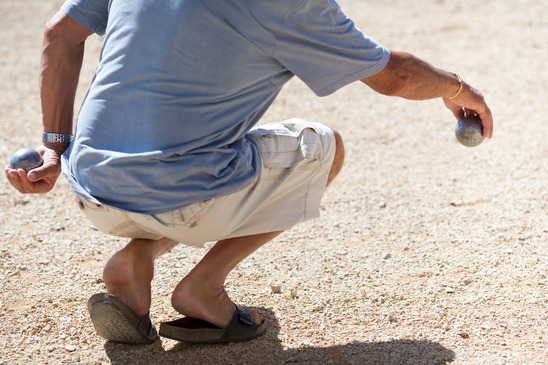 Point a petanque ball according to the ground
Point a petanque ball according to the ground
Finally, if the ground is rather soft (that is to say that the boule rolls shortly after the impact on the ground), it will be wise to lob (play "à la plombée"), and if the ground is hard, we will prefer a more rolling technique. If the court is rough and strewn with obstacles, it's up to you to find the best way to reach your goal !
Squatting or standing ?
You will see players who squat or crouch and others who remain standing when they point, but what is the reason ? You may be surprised, but many players no longer bend down for fear of not getting up again, which is why petanque is a sport that requires good physical condition By crouching, it is easier to observe the ground and spot the various slopes, holes and bumps. When you play "à la plombée" (lob), squatting becomes unnecessary and requires more effort, especially in terms of balance and thighs. Some players will play crouched between 6 and 8 meters and standing between 8 and 10 meters. It is then up to you to choose the position that suits you best !
The balance and the stability
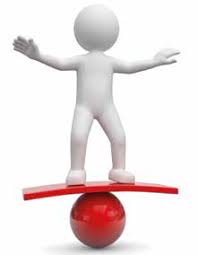 Be careful about your balance when you point
Be careful about your balance when you point
When you point, you use both arms, one to throw the ball and the other to balance. If you are right-handed, then your left arm will balance you. This gesture may seem natural, however few players perform it. When you point, you balance arm should move away from the body as the throwing arm points back. Thanks to this stability, you put all the chances on your side to get a good trajectory, and you spend less energy when throwing the boule. If you are not stable during a point or shot, you will miss a lot of balls !
The flick of a wrist
The flick of a wrist is a flaw of some pointers. They launch their ball by automatically giving it a side effect (left to right or right to left). In France, it is called "coup de main". This "coup de main" has several disadvantages, especially by preventing the realization of :
- "devant de boule" (more details about this word in our glossary) : because of the side effect of the ball, you cannot put your ball just in front of an opposite ball by pointing.
- "jouer les boules" (more details about this word in our glossary) : This technique consists of pushing balls which are in front of the jack by pointing. To use this technique, your trajectory must be straight.
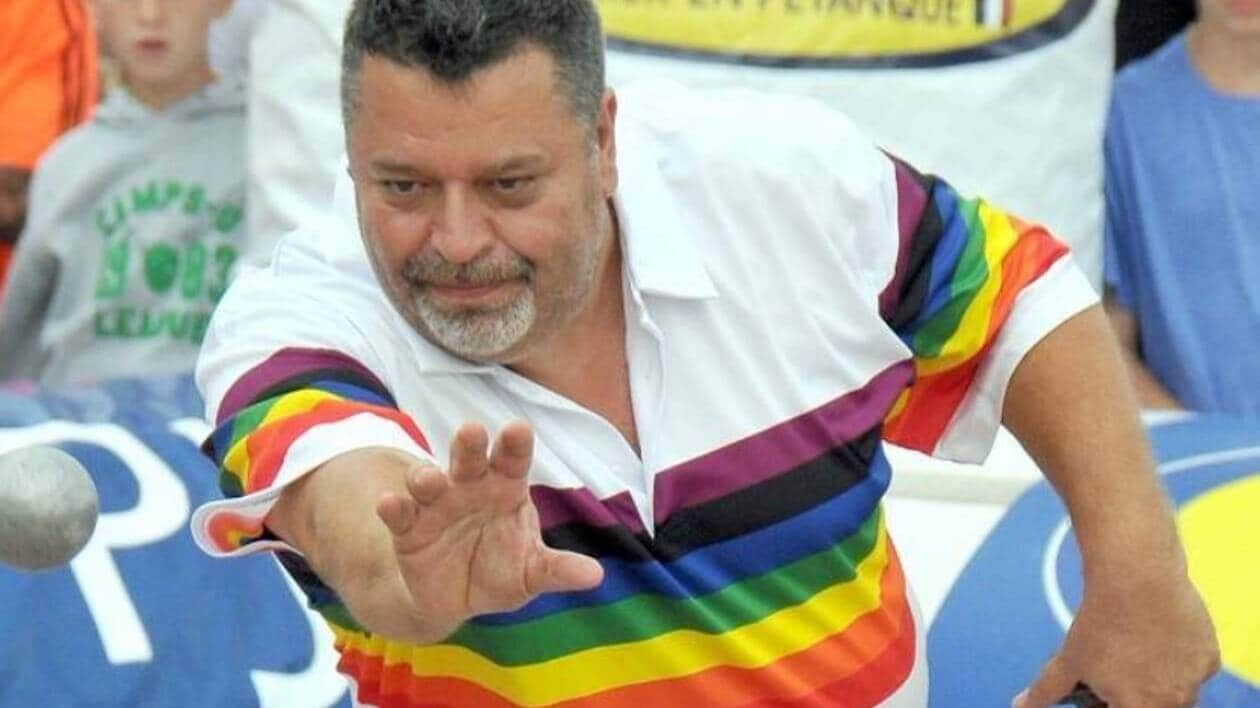 Be careful about wrist when pointing
Be careful about wrist when pointing
Conclusion
Pointing is an art that requires a lot of concentration. This game requires a lot more thinking than shooting, as it depends on the pitch or ground. The point becomes a real pleasure when you start mastering the techniques such as the lob ("à la plombée") or "devant de boule" ...
If you have any remarks or you need help, please contact us.
if you like this tutorial please share it on the social networks.
